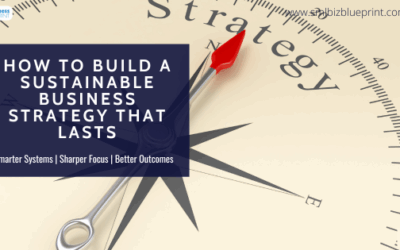The biggest problem for small- to medium-sized businesses can be summed up in three parts: they’re not strategic, they’re not analytical, and they’re not systematic.
Here we will focus on the strategic aspect of running your business.
Most business owners get strategy and tactics confused and I think this is the main reason why they don’t achieve the results they want.
Let’s be clear on the difference between strategy and tactics:
Strategy: a carefully defined and detailed plan to achieve a long-term goal. It is the ultimate position that you would like your business to achieve in the long term
Tactic: a method or technique used to achieve an immediate or short-term gain.
You will design and combine your tactics with the long term strategy in mind.
But is strategy really that important? I mean we all know people that have succeeded but they really didn’t have a strategy.
Strategy is the great work of the organization. In situations of life or death, it is the Tao of survival or extinction. Its study cannot be neglected
Sun Tzu, Chinese General & Author of “The Art of War”
The Evergreen Project is the most statistically rigorous management research ever conducted on the keys to enduring business success. The study examined more than 200 management practices, from innovation and business processes to 360-degree performance reviews. A total of 160 companies were reviewed over a ten-year period to determine which of the management practices were essential to a company’s financial success.
The results showed that the financially successful companies all had a clearly defined and well articulated strategy. No exceptions. These companies outperformed the losing companies by a 945% to 62% margin in total return to shareholders, had a 415% to 83% advantage in sales, a 358% to 97% advantage in assets, a 326% to 22% advantage in operating income and a 5.45% to -8.52% advantage in return on invested capital.
Businesses should only take actions that always—not sometimes, but always—advance and enhance the long-term, well-reasoned game plan of attracting prospects, converting them to clients, and creating a lasting, repeat-buying relationship with them

When it comes to how to create your initial strategy, let’s start at the very beginning.
The first question you have to ask yourself is:
What kind of people or businesses do you want your business to attract and why? What kind of quality and quantity buyers do you want?
Your strategy will change according to your target audience; it goes without saying that you’ll need to strategize differently to reach different kinds of clients.
One major reason for the lack of action is that “new strategies” are often not strategies at all. A real strategy involves a clear set of choices that define what the firm is going to do and what it’s not going to do.
Many strategies fail to get implemented, despite the ample efforts of hard-working people, because they do not represent a set of clear choices.
Many so-called strategies are in fact goals. “We want to be the number one or number two in all the markets in which we operate” is one of those.
It does not tell you what you are going to do; all it does is tell you what you hope the outcome will be. But you’ll still need a strategy to achieve it.
Your strategy can be unsuccessful for a number of reasons but the following 5 reasons are the main ones that will result in your strategy failing.
1. Lack of Buy in From the Team
You can’t execute a strategy alone!
As the owner of your strategic plan, you should really be one of the least important people when it comes to execution.
Why?
Ideally you will keep yourself at arms-length from much of the delivery to allow you to retain perspective and a strategic lens. This only serves to heighten the importance of team buy-in.
A common mistake here is to underestimate the size of your ‘team’ when it comes to having them buy into the plan.
If you have a team of 5, things are fairly easy – all 5 need to be bought in. If you have a team of 50 – things get trickier.
Often we see strategy leads doing a great job of gaining support from their immediate colleagues and direct reports, but a lousy job of ensuring that support cascades throughout the organization.
If you only have buy-in from 5 out of your 50 strong team, then either your strategy will fail through lack of resources – or worse, if it succeeds with that level of buy in, it probably means that it was nowhere near ambitious enough in the first place!
A lot of people assume that communication is a key part of this process – and of course they’re right – but even before you get to the communication stage, you need to start gathering feedback and inviting contributions from your team into any new strategic plan.
Make sure that the first time your team hears about the plan isn’t when it’s finished!
Use tools like surveys, meetings and face to face discussions to gather feedback from your whole organization on topics like:
– The organization’s strengths and weaknesses –
How they feel about the current Vision of the organization –
Who they admire in the industry (competitors) and why Involving people as early as possible will make the next phase of the process (communication) go so much more smoothly!
When it comes to that phase, the key is to communicate early and often. We often see plans kick off with a flurry of workshops and activity, only to see communication tail off rapidly as people return to business-as-usual activities.
Schedule in regular strategy sessions with your team, and stick to them. Failure to address a lack of buy in early is the single biggest reason why strategic plans fail!
 Photo by fauxels from Pexels
Photo by fauxels from Pexels
2. Unclear Objectives
Strategic planning is both easy and hard.
Coming up with ideas about what your organization needs to do and knowing how to do it aren’t usually a problem – but clearly structured plans with well written objectives are much rarer than they should be!
– Have a clear link to the Vision of the organization –
Contain a clear action (a verb), a metric where possible, as well as a tightly defined window of execution (a start and end date) –
Have a single owner or captain – others can collaborate of course, but a single owner avoids ambiguity –
Are reported on a bare minimum of monthly at a regular strategy session or board meeting
A good way to ‘test’ the clarity of your objectives is to ask various people throughout the organization whether they remember and can clearly articulate them – as well as clearly describe how their own work and tasks relate back to a given objective.
If people are able to form this link, then not only is it likely that they are clear about the objective itself, it also suggests that your cascading process has worked effectively.

3. Lack of Alignment
Effectively communicating your strategic plan isn’t the same thing as ensuring alignment.
Alignment means that everyone in the organization can clearly (and accurately) articulate how their own set of goals and tasks are contributing to the strategic plan.
One way to help drive alignment is to create a clear strategic framework and asking people to ‘categorize’ their activities into that framework.
For example, if ‘Innovation, Service and Growth’ are the key Focus Areas of your strategic plan, have people clearly state which of these aspects their various work projects, goals and tasks fall into. Run your team meetings using this structure, slotting in progress updates and agenda items under these headings.
4. Failure to Celebrate Success
One of the nicest and most rewarding (but so often overlooked) things that you can do to successfully deliver your plan. Celebrate!
Sometimes we get so caught up in the doing and the final outcome, that we fail to recognize the great things we achieve along the way.
By celebrating success in delivering our strategy, we reinforce a culture that highlights the importance of strategy to the whole organization.
Let’s say you have 10 strategic objectives that make up your plan – at a minimum you should be celebrating every time you achieve one – even if that means once per month or more regularly.
It doesn’t have to be anything huge – it could be a team lunch, an early office departure on a Friday afternoon or maybe a reward (monetary or otherwise).
Don’t be too finicky about ‘who’ gets to celebrate – this needs to be a whole-team celebration, even if one person or team did more than the rest.
Why?
Because it is your team who will deliver your strategy, not one single person.

5. Failure to Account for Business as Usual
Pragmatism is a key part of any successful plan.
Often when organizations create new plans, they get caught up in the excitement of the ‘new’ and forget to allow enough time to manage existing business activities.
There are two ways that you can deal with this:
Include Business as Usual activities as part of your strategic plan. In theory, a well written plan with clear Focus Areas should encompass the vast majority of your Business as Usual activities.
Managing clients and such-like may not form part of the high level organizational goals – but I’m pretty sure that ‘Client Satisfaction’ would.
Just be careful not to write your new plan to ‘fit’ against your Business as Usual – define what you want to achieve / change first, then see how Business as Usual goals fit into this.
State clearly that your strategic plan does NOT account for Business as Usual activities.
This is probably simpler than (a) but it does have some pitfalls attached. If you’re not careful, you can end up creating a divide in your organization, with some individuals focused on Business as Usual and others on strategic change.

Why Your New Strategy Will Fail
Why isn’t articulating a strategy enough? Why does it often fall down during implementation? What’s actually going on here?
Strategy cannot be implemented if it is not clearly understood, and it cannot be understood if it is not articulated with clarity and simplicity.
Making sure your team understands and can explain the strategy succinctly is an easy way to check that everyone is on the same page.
Often in business, a carefully nurtured and developed opportunity fails to achieve a successful outcome.
Of course, there are many reasons that may contribute, but a key factor is this – the team has failed to execute the business strategy correctly.
A good business leader will explore the reasons behind the lack of success and really learn from them.




